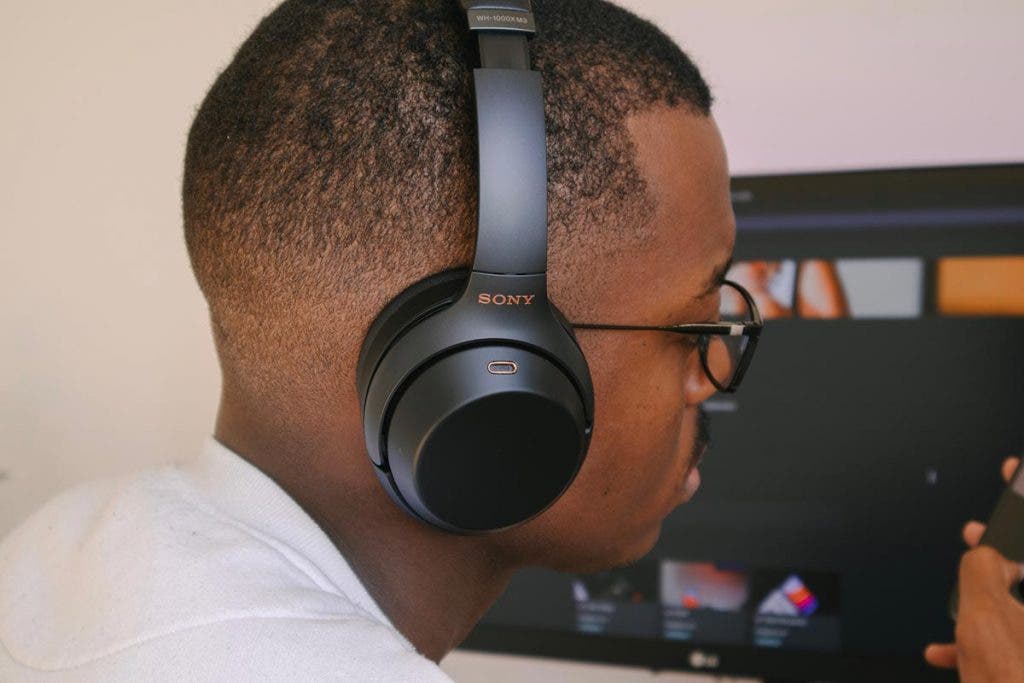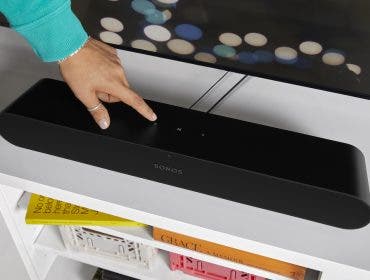These days we’re listening to music on smartphones more than ever before. Unfortunately, those same phones’ internal speakers aren’t capable of delivering the sound we want. Plus, the earbuds that often come packaged with smartphones leave much to be desired. If you’re an audiophile, quality headphones are vital to enjoying high-quality sound anywhere you go. That’s where your choice of in-ear, on-ear, vs over-ear headphones comes in.
There are several types of headphones out there to consider, and they come in different sizes and shapes. Depending on your desired sound quality and the activities you do while jammin’ out, you’ll want either in-ear, on-ear, or over-ear headphones. Check out the differences between in-ear, on-ear, vs over-ear styles in our guide so you can find the best headphones for you.

Go low-profile with in-ear headphones (buds)
In-ear headphones, also known as “earbuds,” are the most common headphones, as anyone who’s ever unboxed an Apple iPhone knows. They’re sleek and subtle, which gives them high grades for portability, and they sit neatly in the ear canal. Some even come with a flexible “bud” so that you can achieve a more comfortable fit.
If you buy wireless Bluetooth-enabled models like the Tannoy Life Buds, other people will hardly know you’re using headphones. They’re also excellent to wear while actively working out, though certain models have a tendency to fall out during more strenuous activity. Consider getting a pair that includes noice cancelling like the Apple Airpods Pro.
The major drawback of in-ear headphones is that they have tiny speakers, which aren’t capable of producing the best sound quality. Also, some of the lower-quality models tend to let in a lot of sounds from the outside world. More than other styles of headphones, you’ll really get what you pay for with in-ear headphones.

Find the middle ground with on-ear headphones
Just as they’re described, on-ear headphones are moderately-sized units that sit directly on your ears without forming the broad seal that over-ear models do. They’ve come a long way from the foam-and-aluminum headband models that accompanied millions of Sony Walkmen in the ‘80s and ‘90s. Most have some sort of form-fitting padding that cushions your ears.
Since they occupy the middle ground between in-ear and over-ear headphones, on-ear models run a huge range of price and quality. The Solo3 Beats by Dre are low-profile wireless headphones, and they’re also priced on the high-end of things. But if you’re not a fan of earbuds and want a basic headset for work or public transit commuting, check out corded models like these Panasonic’s lightweight pair of headphones, which retain excellent comfort and design for under $20.

Go full audiophile with over-the-ear headphones
If you want the best dynamics and tone with the comfort of a pair of earmuffs, you need a pair of over-ear headphones. Largely intended for studio use, corded models like Yamaha’s Professional Over-Ear Monitors let audio engineers hear every subtlety or flaw in a mix. They’re also really comfortable headphones that you can wear for longer periods of time.
Over-ear models are not just for professionals, however. If you’ve ever tried to listen to Beethoven symphony on a train or plane, you may already know that most other types of headphones can’t capture the range of dynamics from a single violin to a full orchestra. You need over-ear models for the best possible listening experience.
These headphones are obviously larger than the others, too, so they’re not the best choice for an active trail run or similar activity. But if you’re concerned about them looking uncool, Beats by Dre has really upped the designer game for over-ear headphones in recent years. You can look fashionable and listen to the highest quality music simultaneously.

Other models and tech to consider
There are many other options for headphones than just the three broad categories here. You have plenty of choices between corded and wireless Bluetooth headphones. Bluetooth-equipped models are lower profile with fewer cord snags to worry about, but require their own battery packs that you’ll need to charge.
For a bit more money, you can get in-ear headphones, on-ear headphones, and over-ear headphones that are “noise cancelling.” These all utilize internal microphones that capture and cancel out low ambient noise like the drone of a jet engine.
You may also want to take the “ear” out of “earphones” entirely and look into “bone-conducting“ headphones. These deliver soundwaves by way of vibrations on your upper cheekbones. If you really want to go full postmodern, Bose even makes a line of “Frames” sunglasses that conduct music to your skull from their earpieces.

In-ear vs On-ear vs Over-ear Headphones: How to Choose the Best Ones for You
Which one sounds better?
Sound quality is paramount when selecting headphones. A few factors in the on-ear vs over-ear debate come into play, and excellent models are available in both categories. Your environment may play a significant role as over-ear headphones naturally block more external noise. For example, if you listen in noisier locales, the over-ears will offer superior sound at the same given volume. However, since they effectively form a seal around your ears, the over-ear versions tend to emphasize specific frequencies and sound a touch “boxy.” Since on-ear models are not sealed in, they offer a cleaner and more natural low-mid bass response.
Which one is more comfortable?
Both on-ear (AKA Supra-Aural) and over-ear (AKA Circumaural) forms can offer excellent fit and comfort depending on the user. Generally, over-ear models will have larger cups with bigger, softer pads. These pads surround the ears providing supreme comfort. This means less pressure on sensitive ears and increased comfort over long listening sessions. Users with sensitive ears will fare better with over-ear models vs on-ear units. However, they tend to be larger and heavier, so some users may prefer the lighter- weight nature of the on-ear models. Many models of both types offer earcups that swivel and can easily adapt to the shape of your head.
Which one is more portable?
In-ear models are usually smaller and lighter, which aids portability. Even when not enjoying music, on-ear headphones are often light enough to wear around your neck for local commuting. Many models offer cases to protect them in transit for more long- range or consistent travel. A key factor to consider here is whether or not the headphones fold up for easy transport.
Which one has better battery life?
When it comes to on-ear vs over-ear headphones, on-ear a smart choice for battery life. Smaller headphones will usually offer better battery life as the drivers within them require less energy to move. Any headphones that offer noise-canceling technology will use more power and need more frequent recharging. If you would like to make sure you never run out of juice, you can always opt for a wired model, which requires no additional power.
When should you pick each?
Listeners in louder environments will generally want more isolation. If you are a recording musician or travel frequently and wish to block out external noise, you will want to go with over-ear models. Users hoping for a more natural soundstage who don’t worry about external noise will want to lean towards the on-ear models. Those looking for lighter, smaller headphones may also choose from in-ears. The media you enjoy will also affect your headphone choice. Standard stereo music will translate fine on either type. Video games rely on cues that utilize the ears’ pinnae (outer portion). Gamers will want over-ear models for this reason.

Other Headphones Features to Consider
Wireless vs Cable
Sometimes, wireless can mean less quality (depending on the system) when compared to a hard wired connection, but cables can get entangled and break. Wireless HPs have the added weight of batteries in them, which you have to charge/replace, but you don’t have to worry about the mess each time you take your HPs out. They have the obvious advantage of being able to move independently from the source, so that might be a good feature to consider if you have such a need.
Closed vs. Open-back
This is really an option with full-sized headphones only, and can boil down to this: open backs usually bring higher quality sound, but have less isolation. This is because of their “open back” design, which lets more air through the back of the speaker.
The more common ones (especially in the lower price range) are the closed back, which also tend to isolate more background noise. Engineers in audio studios tend to gravitate toward the open backs for mixing purposes (if they need to mix on HPs) as they deliver the sense of space extremely well, but when it’s time to track anything in the live room, they always go for the closed back to avoid the “bleed” (unwanted sound from the headphones going into the microphone).
Loudness (Impedance)
How loud a pair of headphones gets depends on their impedance. This might seem like a complicated world of ohms and advanced physics, but really it comes down to this: if you will be using them with a small battery powered device (smartphone, tablets, etc.) go for the HPs with smaller impedance range (16-32 ohms), as they use the power more effectively. If you want to use them with a home stereo or a big headphones amplifier, look for bigger impedance (80-100 ohms).
Noise Cancelling
Some headphones have a special noise cancelling system with little microphones built into them to minimize the background noise. They do this by actively changing the audio being played in that way that when you combine it with the background noise you only get the original audio. Some of them can even do the opposite and let the background noise in, if need be. It’s highly advanced technology, so it can be pricey, but it’s still a very cool feature.
Noise Isolating
The noise isolating feature is meant to deal with the background noise in a passive way. It does so by blocking as much of it as possible with having extra isolating material in the headphones.
Integrated Microphone
A small condenser mic can expand the use of your headphones. For example you can use them as a hands-free headset for your phone. It’s usually integrated in the cable, sometimes coupled with an in-line controller.
In-Line Controller
An in-line controller headphone includes a small control module integrated into the cable (in-line), giving you control over volume and sometimes other basic features, often coupled with a mic.
These are all important considerations to keep in mind, especially when it comes to the environment you will be using your new headphones in. Ultimately it’s important to know your budget so you can implement the features you want/need, and the market today is so diverse that you can be sure to get the best product for you, on your budget.






